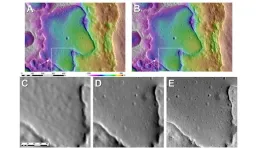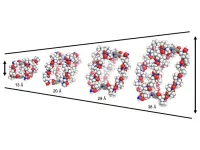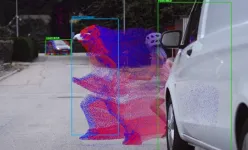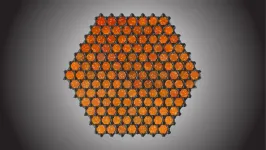(Press-News.org) The waste generated by power generation utility companies could be a potential source of metals and minerals that are key components of modern electronics, batteries, vehicles, and the clean-energy industry as a whole.
Zheng Yao, principal research scientist within Lehigh University’s Energy Research Center (ERC), and a multidisciplinary team of researchers recently received a $2.5 million grant from the Department of Energy (DOE) to identify rare earth elements (REEs) and elements of interest (EOIs) in wastewater and solid waste streams, and to develop the technology that could extract those elements.
The project team includes three faculty members in Lehigh’s P.C. Rossin College of Engineering and Applied Science: ERC Director Carlos Romero, research full professor in mechanical engineering and mechanics; Sibel Pamukcu, a professor of civil and environmental engineering; and Xuanhong Cheng, a professor of bioengineering and materials science and engineering. Stephen Peters, an associate professor of earth and environmental sciences in Lehigh’s College of Arts and Sciences, is also a member of the team, along with collaborators from Western Kentucky University and three U.S. utility companies.
For more than 40 years, the ERC has collaborated with various agencies and industries to address global energy challenges through innovative research, technology development, and student training, focusing today on sustainable power generation and decarbonization. The center is affiliated with Lehigh’s Institute for Cyber Physical Infrastructure and Energy (I-CPIE).
“Energy production creates liquid waste in the form of wastewater, or leachate, and solid waste in the form of ash,” says Yao, the project’s lead researcher. “The volume of landfill leachate is approximately 10 billion gallons per year, and the volume of ash is 190 to 240 billion gallons per year. Developing a means of mineral recovery to reduce the cost of waste treatment while potentially recovering valuable constituents is of great importance.”
According to Yao, there is only one large-scale mine in the United States that extracts REEs that are essential to the batteries that power devices like cell phones and electric vehicles, which are vital to growing the clean-energy economy. Tapping into the vast waste streams generated by utility companies could significantly bolster our national reserves of such materials and reduce our dependence on foreign suppliers.
“Redirecting this waste could also benefit the communities near these plants,” Romero says. “It could reduce the impact of leakages that may occur, and if we could develop a better way to clean the wastewater, that gray water could be utilized by those communities.”
The team will first work to characterize to what extent these waste streams contain REEs and EOIs.
After collecting samples at partner utilities, they’ll revise and streamline the procedures to analyze and measure the samples. They’ll then use electrodialysis—an electrochemical separation process that uses a membrane to concentrate material to enhance the value of the feedstock—to demonstrate that the technology can be used to effectively and efficiently extract and recover the elements.
“We’ll start with a tabletop electrodialytic device that will target REEs and lithium,” says Pamukcu. “It will be a custom-built setup, designed by multiple departments here at Lehigh, because the membrane we need to use must be very selective to allow for specific elements to pass through it.”
The goal is to demonstrate the effectiveness of the technology and to ultimately scale it up to be available commercially.
“Utility companies could use it to mitigate waste and contamination, and as a nation, we would have another domestic feedstock for battery manufacturing,” says Yao. “This is an opportunity to solve significant real-world problems.”
Related Links
Lehigh University: Energy Research Center
DOE project selections (FOA 2796): Water Research & Development for Oil & Gas Produced Water & Coal Combustion Residuals...
ERC: Zheng Yao
Faculty Profile: Carlos E. Romero
Faculty Profile: Xuanhong Cheng
Faculty Profile: Sibel Pamukcu
College of Arts and Sciences/Earth & Environmental Sciences: Steve Peters END
Lehigh University researchers secure $2.5M DOE grant to characterize, extract rare earth elements from utility waste
Energy Research Center (ERC) team will characterize and recover rare earth elements and lithium from waste streams, which could have economic and environmental benefits
2024-05-29
ELSE PRESS RELEASES FROM THIS DATE:
National Science Board elects first industry leader in 30 years
2024-05-29
Darío Gil, Ph.D., IBM Senior Vice President and Director of Research and a member of the Board of Trustees for Rensselaer Polytechnic Institute (RPI), has been elected chair of the National Science Board (NSB).
The NSB is the governing board of the National Science Foundation (NSF) and adviser to Congress and the President on policy matters related to STEM research and STEM education.
“Darío Gil’s insights and innovative thinking will be indispensable to his leadership of the NSB,” said RPI President Martin A. Schmidt, Ph.D. “His election speaks volumes about his exceptional talents ...
New technique from Brown University researchers offers more precise maps of the Moon’s surface
2024-05-29
PROVIDENCE, R.I. [Brown University] — A new study by Brown University researchers may help redefine how scientists map the surface of the Moon, making the process more streamlined and precise than ever before.
Published in the Planetary Science Journal, the research by Brown scholars Benjamin Boatwright and James Head describes enhancements to a mapping technique called shape-from-shading. The technique is used to create detailed models of lunar terrain, outlining craters, ridges, slopes and other surface hazards. By analyzing the way light hits different surfaces of the Moon, it allows researchers to estimate the three-dimensional ...
Dariusz Stramski selected as 2024 recipient of the Nils Gunnar Jerlov Medal
2024-05-29
Professor Dariusz Stramski of Scripps Institution of Oceanography at UC San Diego has been selected by The Oceanography Society as the 2024 recipient of the Nils Gunnar Jerlov Medal in recognition of his significant and wide-ranging contributions to the field of optical oceanography.
With a distinguished career spanning over 40 years, Dr. Stramski has made profound impacts on the study of ocean optics. Born in Poland, Stramski received his M.S. with honors in oceanography (1978) and Ph.D. in Earth ...
AI health coach lowers blood pressure and boosts engagement in patients with hypertension
2024-05-29
(Toronto, May 28, 2024) A new study in JMIR Cardio, published by JMIR Publications, shows that a fully digital, artificial intelligence (AI)–driven lifestyle coaching program can effectively reduce blood pressure (BP) in adults with hypertension. This AI-based program leverages data from wearable activity trackers and BP monitors as well as a mobile app questionnaire to tailor lifestyle guidance. The research team, led by Jared Leitner of the University of California, San Diego, used this innovative intervention to help manage ...
AI saving humans from the emotional toll of monitoring hate speech
2024-05-29
A team of researchers at the University of Waterloo have developed a new machine-learning method that detects hate speech on social media platforms with 88 per cent accuracy, saving employees from hundreds of hours of emotionally damaging work.
The method, dubbed the Multi-Modal Discussion Transformer (mDT), can understand the relationship between text and images as well as put comments in greater context, unlike previous hate speech detection methods. This is particularly helpful in reducing false positives, which are often ...
Chicken feathers to deliver chemotherapy drugs and repair enzymes
2024-05-29
A new method of drug delivery using proline, an amino acid found in chicken feathers and skin tissue, could be used to limit the side effects of chemotherapy and repair important enzymes, new research suggests.
Published in the journal Chem today, researchers have designed a cage (a box made of single molecules) from biologically compatible peptides, short amino acids that form the basis of proteins. These cages can house drugs of different sizes and transport them in the body with high levels of precision.
The negative ...
Bio-inspired cameras and AI help drivers detect pedestrians and obstacles faster
2024-05-29
It’s every driver’s nightmare: a pedestrian stepping out in front of the car seemingly out of nowhere, leaving only a fraction of a second to brake or steer the wheel and avoid the worst. Some cars now have camera systems that can alert the driver or activate emergency braking. But these systems are not yet fast or reliable enough, and they will need to improve dramatically if they are to be used in autonomous vehicles where there is no human behind the wheel.
Quicker detection using less computational ...
Graphene gets cleaned up
2024-05-29
Graphene has been called “the wonder material of the 21st century.” Since its discovery in 2004, the material—a single layer of carbon atoms—has been touted for its host of unique properties, which include ultra-high electrical conductivity and remarkable tensile strength. It has the potential to transform electronics, energy storage, sensors, biomedical devices, and more. But graphene has had a dirty little secret: it's dirty.
Now, engineers at Columbia University and colleagues at the University of Montreal and the National Institute of Standards and Technology are poised to clean things up with an oxygen-free chemical vapor ...
Study finds older adults hospitalized for heart failure had high risk of kidney complications
2024-05-29
In a study of Medicare beneficiaries, researchers from Brigham and Women’s Hospital found that one year after hospitalization for heart failure, 6 percent of patients had progressed to dialysis.
KEY TAKEAWAYS
Study led by Brigham researchers found that among older adults hospitalized for heart failure, nearly 3 in 4 were discharged with reduced kidney function.
Lower kidney function was associated with substantially higher risk of kidney complications and other adverse clinical outcomes among older adults, with more than 1 in 20 progressing to dialysis within one year after heart failure hospitalization.
These findings emphasize the need ...
Editing without “cutting”: Molecular mechanisms of new gene-editing tool revealed
2024-05-29
Joint research led by Yutaro Shuto, Ryoya Nakagawa, and Osamu Nureki of the University of Tokyo determined the spatial structure of various processes of a novel gene-editing tool called “prime editor.” Functional analysis based on these structures also revealed how a “prime editor” could achieve reverse transcription, synthesizing DNA from RNA, without “cutting” both strands of the double helix. Clarifying these molecular mechanisms contributes greatly to designing gene-editing tools accurate enough for gene therapy treatments. The findings were published in the journal Nature.
The ...
LAST 30 PRESS RELEASES:
Tracing the quick synthesis of an industrially important catalyst
New software sheds light on cancer’s hidden genetic networks
UT Health San Antonio awarded $3 million in CPRIT grants to bolster cancer research and prevention efforts in South Texas
Third symposium spotlights global challenge of new contaminants in China’s fight against pollution
From straw to soil harmony: International team reveals how biochar supercharges carbon-smart farming
Myeloma: How AI is redrawing the map of cancer care
Manhattan E. Charurat, Ph.D., MHS invested as the Homer and Martha Gudelsky Distinguished Professor in Medicine at the University of Maryland School of Medicine
Insilico Medicine’s Pharma.AI Q4 Winter Launch Recap: Revolutionizing drug discovery with cutting-edge AI innovations, accelerating the path to pharmaceutical superintelligence
Nanoplastics have diet-dependent impacts on digestive system health
Brain neuron death occurs throughout life and increases with age, a natural human protein drug may halt neuron death in Alzheimer’s disease
SPIE and CLP announce the recipients of the 2025 Advanced Photonics Young Innovator Award
Lessons from the Caldor Fire’s Christmas Valley ‘Miracle’
Ant societies rose by trading individual protection for collective power
Research reveals how ancient viral DNA shapes early embryonic development
A molecular gatekeeper that controls protein synthesis
New ‘cloaking device’ concept to shield sensitive tech from magnetic fields
Researchers show impact of mountain building and climate change on alpine biodiversity
Study models the transition from Neanderthals to modern humans in Europe
University of Phoenix College of Doctoral Studies releases white paper on AI-driven skilling to reduce burnout and restore worker autonomy
AIs fail at the game of visual “telephone”
The levers for a sustainable food system
Potential changes in US homelessness by ending federal support for housing first programs
Vulnerability of large language models to prompt injection when providing medical advice
Researchers develop new system for high-energy-density, long-life, multi-electron transfer bromine-based flow batteries
Ending federal support for housing first programs could increase U.S. homelessness by 5% in one year, new JAMA study finds
New research uncovers molecular ‘safety switch’ shielding cancers from immune attack
Bacteria resisting viral infection can still sink carbon to ocean floor
Younger biological age may increase depression risk in older women during COVID-19
Bharat Innovates 2026 National Basecamp Showcases India’s Most Promising Deep-Tech Ventures
Here’s what determines whether your income level rises or falls
[Press-News.org] Lehigh University researchers secure $2.5M DOE grant to characterize, extract rare earth elements from utility wasteEnergy Research Center (ERC) team will characterize and recover rare earth elements and lithium from waste streams, which could have economic and environmental benefits








